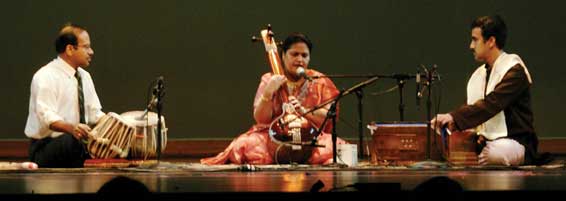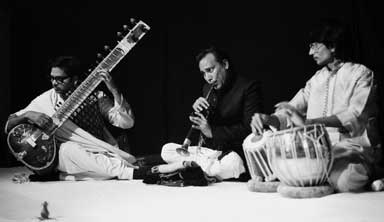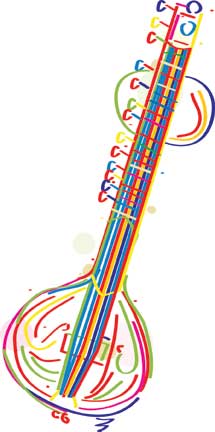Ullas Ponnadi
(This article is the concluding one in the series. Part 1 and 2 are referenced below:
Part 1: https://www.teacherplus.org/music-and-artificial-intelligence/
Part 2: https://www.teacherplus.org/digital-tools-to-create-music/
Let us pick up from the concluding thoughts of Part 2)
For a person blessed with musical ears and the ability to appreciate music, music becomes a serious, personal inner journey. A vast ocean to be explored, the depth of which is bottomless, the breadth of which is wider that the spread of the universe! Given this, how does one focus, learn, narrow down, become a musician, then a performer, and thus combine the inner journey but still aspire to make a career of it?
Let us start with the examples of a few musicians who are leading satisfying musical and professional lives.
Aishwarya is a vocalist who has learnt Carnatic classical music and is now learning Hindustani classical music. Based in Kerala, she is an independent musician who has published a few of her works. Her debut composition, Nila, was recognized as the Best Non-Film Album at the Red FM Malayalam Music Awards in 2019. She also teaches music, while continuing to perform and record. She is a PhD in English and teaches at a well-known local college. A perfect example of a person who has managed to sustain her passion for music along with strong academic credentials that provide her with livelihood. She continues to explore both facets of her life.

Vivek T P is a classically trained vocalist, who ran a parallel college for two decades, which taught English and commerce to undergraduate students in Wandoor, Kerala. He then switched to music full time and now combines stage performances, studio recordings, composing, anchoring at AIR FM Kochi and teaching music. He continues to learn music and has successfully transitioned to music as a career. For the past several years, he is the architect and anchor of a music group called Hrudaygeet, which delivers songs from the heart to listeners, mostly via live programs and using authentic instruments, combining old classics, ghazals and bhajans across India and abroad.
Ratnashree Iyer is an MSc in chemistry, who is now pursuing a PhD in the “Science of Tabla”. She has travelled across the globe as a performing artist. She is the only female classical tabla player in South India. She has won several accolades; her recent notable achievement is winning the Kerala Sangeeta Nataka Academy (KSNA) award for playing the tabla. She has experimented with various forms of percussion collaborations. While academics is not her priority, she is combining that with her core passion (tabla) as an art form. She collaborates with artists of Hindustani and Carnatic genre, via live stage and recordings and also teaches chemistry to high school students.
Pradeep Somasundaram, Principal, College of Applied Science (Managed by IHRD, A Government of Kerala undertaking) Malampuzha, Palakkad. An established singer, here’s what he had to tell me:
“It was unfortunate that in my formative years, I was unable to learn the basics of classical music, which is extremely important to get the fundamentals strong. Adding that in the school curriculum can be of great value to students who wish to pursue music. Tracing my journey backwards and mapping that to the mass audience as listeners in India, the audience is more tuned to film music rather than independent works and non-film-based music, as in say Hindustani and Carnatic classical concerts and albums, regional folk songs, bhajans and so on. A singer’s stature and commercial value is thus mostly based on their reputation in film music, and that is an extremely narrow space for singers to succeed. Hence, pursuing music as a career is very tough and limited to a handful. We have seen how the next level musicians are suffering due to the pandemic. Music and stage revival seems to be the last priority for the government and the audience, and there is hardly any other form of monetary support for them. I am fortunate that I have an alternate profession and do not have to worry about livelihood.”
Sajith Pallipuram, a close friend, an engineer by qualification, successful serial entrepreneur, is now making a mark in the field of music. He resumed his musical journey after a 30-year hiatus. About five years ago, he resumed his musical lessons from the well-known carnatic vocalist, Sangita Kala Acharya Smt. Radha Namboodiri, who is now based in Mumbai. The journey was hard, but he persisted with faith. He discovered that he could compose. He picked a genre that was getting lost, music that is native to Kerala, uses simple and authentic vocals and instruments and connects deeply with the heart and soul of the listeners. His persistence, focus and determination, helped him rediscover himself and led to the creation of the music channel, Music Mumbe, which creates top quality music and has a serious audience. He himself composes and sings many of his works, but he also pulls in the best musicians together. As of now, it is a free channel. He believes that once the channel has enough people subscribing to it, the commerce will follow. An amazing story that very few dare to even attempt. An inspiration and model for those who believe that if one cannot sustain music in their formative years, it will get lost in the sands of time!
To an ardent lover of music who dreams, eats, sleeps music, it is difficult to focus elsewhere and think of a career sans music. But it is also important to understand that there are millions of such people, and only a select few can make it to the top. For the rest, stages and sponsors are important and that can become a real challenge, especially now due to the pandemic.

The examples above give us a glimpse of how one can combine the pursuit of art, specifically music, while also pursuing academics and thus find a balance where livelihood is taken care and art is sustained.
As we wrap up this series, let us have an open-ended exploration of analog and digital music. Analog as in open stage, live, real instruments, un-doctored versus digitally created, mixed, mastered music and then try to compare these and their longevity.
Why do live stage programs with limited musicians and classical musicians with limited instruments to accompany, still find a connect with the audience? Does that mean that such music will continue to thrive and will find an alternate and possibly more mainstream audience? Or will they be relegated and become insignificant, as AI and associated algorithms become more and more powerful and perfect and create those perfect digitally recorded music or enhance and correct live sage music?
Does digital perfection mean that we tend to lose out on emotions embedded in musical creations? If digital music is so perfect, why is it that the music of the past, recorded using ancient technology, sometimes noisy, and often imperfect, is still charming and finds a nostalgic audience? More importantly, why do we listen to these over and over again and not tire of them? What magic could have been created and captured, during the process of creation of such music, which lingers as an everlasting perfume?
What really is the magic that music and musicians create that touches people’s heart and soul? Is it merely the mathematics and physics of sound and their numerous permutations and combinations, or is there something more?
Would it be safe to infer that there is something in the art form of music, which transcends the science of it? What is that? What is the art in music?

If you sit in an Indian classical music concert, there is a strange connection between the performers on the stage and the audience. The ambience also adds to that, for example, music performed in a temple can create a completely different experience as compared to one in a sound perfect auditorium. In addition, the performers’ emotions play a big part in how the creation is conceived and rendered. Every moment in space and time is unique and the art that evolves and morphs is based on that too.
What is the role of the audience then? I have observed that when the audience connects well with the musicians, the performance becomes richer, and at some point, the listener becomes as or even more important than the performer. A magical symphony of art, where the entire ambience, the performer, the listener, and the venue become one, on a large extended stage.
What about western classical music that has everything written down to exact notes and beats, and to its intricate variations? What then is the role of a human conductor and why is one symphony better that the other?
As I have understood, it is the reproduction of the interpretation of the written notes, that differentiates performances. There is freedom in that interpretation and that brings in the value of a human conductor. If not, an AI based algorithm and robots playing instruments could very well replace the entire symphony!

If you ask a performer the reason behind their exceptional performance on a certain day, they all seem to converge to a single answer. I do not know. The most common phrase I have heard is that all forms of music are floating in the universe and the super intelligent nature finds a performer, on a given day, at a given moment, as a medium to express that and deliver it to the listener. Strange it may sound, for we know how much rigor and practice has gone into the creation by these musicians, before they even attempted a single performance!
Which could explain why imperfectly recorded music, as we analyze via the current digital techniques, is still soulful and sticks with us. Which is possibly why we still like to listen to live performances, for that momentary connect with our inner soul and the universe. Which is possibly why for the child, a mothers’ lullaby is far more musical than the best symphony in the world.
Digital world, AI and algorithms and soft bots can definitely create what we can interpret as perfect music. With some element of randomness thrown in, it can also possibly create the emotions. It can be far superior to humans and other living beings in consistently creating perfect music. It can certainly aid the learnings of a performer and help create scores for movies. As AI evolves, it can possibly create far more complex music than humans can ever imagine! For its capability is exploding each day.
But in the billions of years of the universe and the millions of years of life’s evolution, there is an umbilical cord between the creator and the creation, which also finds its way via musical expression. The bot is a human creation, and not yet connected with the universe. The bot is a recent creation and cannot express emotions as rich as nature’s creations. That is where the bot still has to evolve. Maybe it will happen, maybe it won’t.
It is fascinating to walk in a dense forest, created over thousands of years, untouched by human urge for perfection, witnessing growths of all kinds, tall trees, shrubs, grass, creepers, bushes, and those diverse living beings, insects, birds, animals, all living together in perfect symphony, as perfect as the best musical symphony that was ever created. Imperfect as compared to the nicely cut bio creations of humans, as we see at an airport, or homes, or a large park.
No two forests are alike. For they are distinct creations of nature.
Music has a parallel analogy. When musicians come together, they can create that dense and rich musical forest. And no two such performances are the same, they have their unique charm in space and time. AI and bots are not there yet. Maybe they never will!
As teachers, students, listeners and patrons of music, we must aspire to seamlessly blend the art and the inner journey of music, with the science and the ornamental decorations that it can bring around it. That is still a widely open, unexplored, and extremely fascinating field, for both the arts and science students.
Let us then believe that we will find a beautiful and collaborative mechanism, where the universe’s creations and human creations, will co-exist in perfect harmony, and one will not override the other. For, the purpose of every single creation is to make life richer, without losing value in our own creativity or interfering with nature’s.
The author is an EdTech Entrepreneur and a Learning Consultant with 3 plus decades of experience in IT Engineering, Innovation, and Learning spaces. He is the co-founder of four ventures, starting year 2013. He is very passionate about education and learning, and its power to transform young minds and keep the old young. He can be reached at uponnadi@gmail.com.
